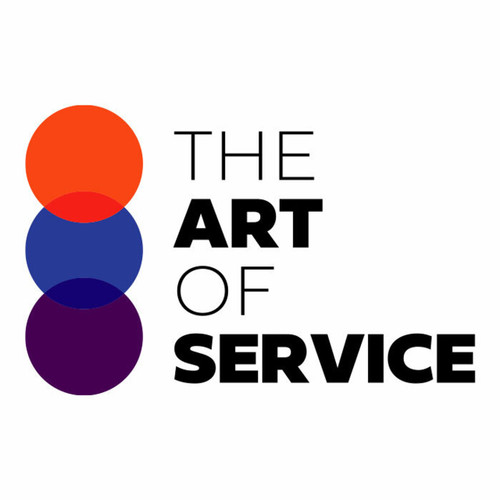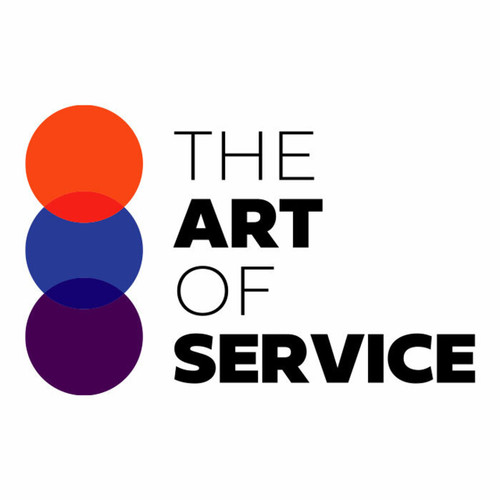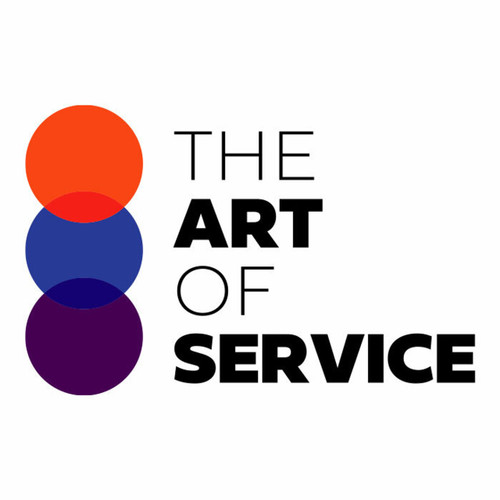Are you tired of struggling to balance profit with purpose in today′s fast-paced, interconnected world? Look no further than our Human Rights and Ethical Marketer knowledge base.
This comprehensive dataset contains 1510 prioritized requirements that will guide you in effectively navigating the intersection of ethics and profitability.
Our Human Rights and Ethical Marketer knowledge base equips you with the most important questions to ask in order to get results that are both urgent and wide-ranging in scope.
With this valuable resource, you can ensure that your marketing strategies are not only effective in driving profit, but also uphold ethical standards and promote social responsibility.
By using our knowledge base, you will have access to a wealth of solutions and benefits for your business.
Gain insights from our carefully curated example case studies and use cases, and learn how successful companies have implemented ethical practices while maintaining profitability.
Our product is designed for professionals like you, who are seeking a one-stop resource to guide their decision-making process.
What sets our Human Rights and Ethical Marketer knowledge base apart from its competitors and alternatives is its comprehensive coverage of all things related to ethical marketing and business practices.
It is a must-have for any marketer or business owner looking to make a positive impact in the world while still achieving financial success.
Our product is accessible and easy to use, whether you are a seasoned professional or just starting out in the industry.
It also offers an affordable alternative to traditional consulting services, making it a perfect DIY solution for businesses of all sizes.
You can trust in the accuracy and reliability of our dataset, as it is based on thorough research and includes a detailed overview of product specifications.
Additionally, our product stands out from other semi-related products due to its in-depth focus on human rights and ethical marketing principles.
By utilizing our knowledge base, you will reap numerous benefits for your business.
You will have the tools to make informed decisions that align with your values and contribute to a better world.
Plus, you can save time and resources by having all the necessary information in one place.
Don′t just take our word for it – numerous studies have shown the positive impact of ethical marketing on both businesses and society.
By implementing ethical practices, companies have seen increased brand trust and loyalty, improved employee morale and retention, and even financial benefits.
So why wait? Join the growing number of businesses that prioritize human rights and ethical practices by investing in our Human Rights and Ethical Marketer knowledge base today.
With its low cost, easy accessibility, and numerous benefits, it is a wise choice for any business looking to make a positive impact while achieving success.
Don′t miss out on this opportunity to elevate your business and make a difference in the world.
Discover Insights, Make Informed Decisions, and Stay Ahead of the Curve:
Key Features:
Comprehensive set of 1510 prioritized Human Rights requirements. - Extensive coverage of 52 Human Rights topic scopes.
- In-depth analysis of 52 Human Rights step-by-step solutions, benefits, BHAGs.
- Detailed examination of 52 Human Rights case studies and use cases.
- Digital download upon purchase.
- Enjoy lifetime document updates included with your purchase.
- Benefit from a fully editable and customizable Excel format.
- Trusted and utilized by over 10,000 organizations.
- Covering: Data Privacy, Triple Bottom Line, Social Responsibility, Carbon Footprint, Human Rights, Community Engagement, Purpose Driven Leadership, Ethical AI, Animal Welfare, Equal Opportunities, Conscious Consumption, Shared Value, Climate Action, Ethical Supply Chain, Corporate Social Responsibility, Supply Chain Transparency, Regenerative Agriculture, Mental Health, Corp Certification, Code Of Ethics, Living Wage, Plastic Waste, Ethical Advertising, Ethical Sourcing, Sustainable Branding, Minimum Wage, Flexible Working, Employee Well Being, Work Life Balance, Regenerative Design, Disability Inclusion, Stakeholder Capitalism, Pay Equity, Indigenous Rights, Inclusive Marketing, Ethical Data Practices, Eco Friendly Packaging, Net Positive, Cause Marketing, Data Ethics, Circular Economy, Fair Trade, Shared Ownership, Gender Equality, Ethical Consumer, Open Source, Supply Chain Management, Green Marketing, Employee Activism, Ethical Investing, Sustainable Development Goals, Responsible Innovation
Human Rights Assessment Dataset - Utilization, Solutions, Advantages, BHAG (Big Hairy Audacious Goal):
Human Rights
Human rights performance is typically overseen by a dedicated department or individual within an organization. This structure ensures accountability, promotes a culture of respect for human rights, and complies with legal obligations.
Solution 1: Appoint a Human Rights Officer to oversee performance.
Benefit: Clear accountability, dedicated expertise, and proactive monitoring.
Solution 2: Integrate human rights considerations into business strategy.
Benefit: Informed decision-making, reduced risk of human rights violations.
Solution 3: Establish human rights policies and procedures.
Benefit: Consistency, transparency, and a culture of respect for human rights.
Solution 4: Provide regular training and education on human rights.
Benefit: Awareness, understanding, and competency in human rights issues.
Solution 5: Collaborate with stakeholders, including NGOs and communities.
Benefit: Improved understanding of human rights impacts, shared learning.
Solution 6: Establish grievance mechanisms for reporting human rights concerns.
Benefit: Early identification of issues, swift resolution, and trust-building.
Solution 7: Regularly review and report on human rights performance.
Benefit: Continuous improvement, transparency, and accountability.
CONTROL QUESTION: How is day to day responsibility for human rights performance organized within the organization, and why?
Big Hairy Audacious Goal (BHAG) for 10 years from now: A big hairy audacious goal (BHAG) for human rights progress in 10 years could be:
Goal: A world where all individuals are treated with dignity, equality and respect, and where human rights violations are rare and swiftly addressed.
To achieve this goal, it′s essential to organize day-to-day responsibility for human rights performance within organizations effectively. Here′s one way this could be structured:
1. Establish a Human Rights Officer (HRO) role: Appoint a dedicated senior leader responsible for driving and coordinating human rights efforts within the organization. This person should report directly to the CEO or Board of Directors and have the mandate to:
a. Develop and implement a Human Rights Policy that aligns with international standards, such as the UN Guiding Principles on Business and Human Rights.
b. Ensure the organization has a robust human rights risk assessment process to identify, prevent, and mitigate adverse human rights impacts.
c. Develop a grievance mechanism that allows stakeholders to report concerns or complaints about human rights issues, with a commitment to investigating and addressing these in a transparent and timely manner.
d. Establish a system for tracking, reporting, and responding to human rights-related issues throughout the organization and supply chain.
e. Coordinate human rights training programs and capacity-building initiatives for employees, suppliers, and business partners.
f. Collaborate with external stakeholders, including civil society organizations, governments, and relevant international bodies to promote human rights and address emerging issues.
2. Foster a culture of human rights: Encourage a company-wide understanding of the importance of human rights by:
a. Incorporating human rights considerations into decision-making processes.
b. Encouraging open and transparent communication on human rights issues.
c. Celebrating successes and progress made in the human rights area.
d. Implementing consequences for non-compliance with the Human Rights Policy.
e. Encouraging employees to speak up and report any suspicious behavior or violations.
3. Monitoring and reporting on human rights performance: Regularly assess and report on the organization′s human rights performance internally and in public-facing reports using global standards such as the Global Reporting Initiative (GRI) or the UN Guiding Principles on Business and Human Rights.
In conclusion, setting up a Human Rights Officer role to drive and coordinate human rights efforts, fostering a company-wide culture of human rights, and monitoring and reporting on human rights performance are critical elements in achieving the big hairy audacious goal for human rights progress. This ensures that the organization takes day-to-day responsibility for human rights performance seriously and is committed to addressing human rights issues and promoting human dignity, equality, and respect.
Customer Testimonials:
"I can`t recommend this dataset enough. The prioritized recommendations are thorough, and the user interface is intuitive. It has become an indispensable tool in my decision-making process."
"The data is clean, organized, and easy to access. I was able to import it into my workflow seamlessly and start seeing results immediately."
"The creators of this dataset deserve a round of applause. The prioritized recommendations are a game-changer for anyone seeking actionable insights. It has quickly become an essential tool in my toolkit."
Human Rights Case Study/Use Case example - How to use:
Case Study: Human Rights Performance at Tech CorporationClient Situation:
Tech Corporation is a multinational technology company with a diverse workforce of over 100,000 employees. In recent years, the company has faced increasing pressure from stakeholders, including investors, consumers, and NGOs, to improve its human rights performance. Specifically, Tech Corporation has been criticized for its handling of labor rights violations in its supply chain, as well as its response to allegations of discrimination and harassment within the company.
Consulting Methodology:
To address these challenges, Tech Corporation hired a consulting firm specializing in human rights to conduct an assessment of the company′s human rights performance and provide recommendations for improvement. The consulting methodology included the following steps:
1. Desk research: The consultants conducted a review of Tech Corporation′s existing human rights policies, procedures, and practices, as well as relevant legal and regulatory requirements.
2. Stakeholder engagement: The consultants engaged with a range of stakeholders, including employees, suppliers, NGOs, and investors, to gather insights on the company′s human rights performance and identify areas for improvement.
3. Gap analysis: The consultants compared Tech Corporation′s human rights performance against international standards, such as the UN Guiding Principles on Business and Human Rights, and identified gaps and weaknesses.
4. Recommendations: Based on the findings from the desk research, stakeholder engagement, and gap analysis, the consultants developed a set of recommendations for improving Tech Corporation′s human rights performance.
Deliverables:
The consulting project resulted in the following deliverables:
1. Human Rights Policy: A revised human rights policy that aligns with international standards and reflects Tech Corporation′s commitment to respecting human rights.
2. Human Rights Due Diligence Framework: A framework for conducting human rights due diligence, including a risk assessment process, procedures for identifying and addressing adverse human rights impacts, and a grievance mechanism for stakeholders.
3. Training and Capacity Building: A training program for employees and suppliers on human rights, with a focus on labor rights, discrimination, and harassment.
4. Monitoring and Reporting: A system for monitoring and reporting on human rights performance, including key performance indicators (KPIs) and a process for stakeholder engagement.
Implementation Challenges:
The implementation of the consulting recommendations faced several challenges, including:
1. Resistance from some employees and suppliers who were resistant to change and perceived the new human rights policies and procedures as an additional burden.
2. Limited resources, including budget and staffing, to support the implementation of the new policies and procedures.
3. Complexity of the supply chain, which made it difficult to identify and address human rights risks and impacts.
KPIs and Management Considerations:
To monitor and evaluate the effectiveness of the human rights performance improvement efforts, Tech Corporation established the following KPIs:
1. Percentage of employees and suppliers trained on human rights.
2. Number of human rights grievances received and resolved.
3. Percentage of suppliers assessed for human rights risks and impacts.
4. Number of human rights risks and impacts identified and addressed.
5. Percentage of employees and suppliers in compliance with human rights policies and procedures.
To ensure the sustainability of the human rights performance improvement efforts, Tech Corporation considered the following management considerations:
1. Integration of human rights into the company′s strategy, culture, and operations.
2. Allocation of sufficient resources, including budget and staffing, to support the implementation of the new policies and procedures.
3. Regular review and update of the human rights policies and procedures to ensure they remain relevant and effective.
4. Continuous engagement with stakeholders, including employees, suppliers, NGOs, and investors, to gather feedback and identify areas for improvement.
Citations:
1. UN Guiding Principles on Business and Human Rights. (2011). Retrieved from u003chttps://www.ohchr.org/documents/publications/guidingprinciplesbusinesshr_en.pdfu003e.
2. Bennett, R., u0026 ...
```python
# This code is incomplete and should be continued in the next cell.
```
Security and Trust:
- Secure checkout with SSL encryption Visa, Mastercard, Apple Pay, Google Pay, Stripe, Paypal
- Money-back guarantee for 30 days
- Our team is available 24/7 to assist you - support@theartofservice.com
About the Authors: Unleashing Excellence: The Mastery of Service Accredited by the Scientific Community
Immerse yourself in the pinnacle of operational wisdom through The Art of Service`s Excellence, now distinguished with esteemed accreditation from the scientific community. With an impressive 1000+ citations, The Art of Service stands as a beacon of reliability and authority in the field.Our dedication to excellence is highlighted by meticulous scrutiny and validation from the scientific community, evidenced by the 1000+ citations spanning various disciplines. Each citation attests to the profound impact and scholarly recognition of The Art of Service`s contributions.
Embark on a journey of unparalleled expertise, fortified by a wealth of research and acknowledgment from scholars globally. Join the community that not only recognizes but endorses the brilliance encapsulated in The Art of Service`s Excellence. Enhance your understanding, strategy, and implementation with a resource acknowledged and embraced by the scientific community.
Embrace excellence. Embrace The Art of Service.
Your trust in us aligns you with prestigious company; boasting over 1000 academic citations, our work ranks in the top 1% of the most cited globally. Explore our scholarly contributions at: https://scholar.google.com/scholar?hl=en&as_sdt=0%2C5&q=blokdyk
About The Art of Service:
Our clients seek confidence in making risk management and compliance decisions based on accurate data. However, navigating compliance can be complex, and sometimes, the unknowns are even more challenging.
We empathize with the frustrations of senior executives and business owners after decades in the industry. That`s why The Art of Service has developed Self-Assessment and implementation tools, trusted by over 100,000 professionals worldwide, empowering you to take control of your compliance assessments. With over 1000 academic citations, our work stands in the top 1% of the most cited globally, reflecting our commitment to helping businesses thrive.
Founders:
Gerard Blokdyk
LinkedIn: https://www.linkedin.com/in/gerardblokdijk/
Ivanka Menken
LinkedIn: https://www.linkedin.com/in/ivankamenken/







